15 years one-stop China custom CNC machining parts factory
 1315 |
Published by VMT at Aug 31 2024
1315 |
Published by VMT at Aug 31 2024
Black anodizing is a specialized surface treatment process widely used in the manufacturing industry, particularly in the production of high-performance, durable, and aesthetically pleasing parts. This process involves electrochemical conversion, which enhances the surface properties of metals, making them more resistant to corrosion, wear, and abrasion while providing an appealing black finish. Black anodized CNC machining parts are commonly used in various industries, including aerospace, automotive, electronics, and architecture, where both functionality and aesthetics are crucial. This article delves into the black anodizing process, exploring its different types, benefits, applications, and the step-by-step method of black anodizing materials, with a particular focus on CNC machined parts.

Anodizing is an electrochemical process that converts the surface of a metal into a durable, corrosion-resistant, anodic oxide finish. This oxide layer is not applied to the surface but is grown from the metal itself, making it integral to the substrate. Anodizing enhances the material's appearance, improves its resistance to wear and corrosion, and provides a better surface for applying additional coatings, such as dyes. The process is most commonly applied to aluminum but can also be used on other non-ferrous metals like magnesium, titanium, and zinc.
Type I – Chromic Acid Anodizing:
This process uses chromic acid as the electrolyte. It's the oldest and least aggressive anodizing method, often used for aerospace applications due to its lower impact on the material's fatigue properties. Chromic acid anodizing produces a thinner oxide layer, typically less than 1 micron thick, which is suitable for parts requiring high precision and minimal dimensional change.
Type II – Sulfuric Acid Anodizing:
The most common type of anodizing, Type II uses sulfuric acid as the electrolyte. This process creates a thicker oxide layer, ranging from 5 to 25 microns, depending on the application. It is widely used for both protective and decorative purposes, making it ideal for consumer products, architectural elements, and automotive components. Type II anodizing can be dyed in various colors, including black, to meet aesthetic and functional requirements.
Type III – Hard Anodizing:
Also known as hard coat anodizing, this process uses sulfuric acid at lower temperatures and higher current densities to produce a much thicker oxide layer, typically between 25 to 150 microns. Type III anodizing is used when extreme hardness, wear resistance, and corrosion resistance are required. It is commonly applied to parts subjected to heavy use or harsh environments, such as military, aerospace, and industrial equipment.
Black anodizing is a specific type of anodizing process where the anodized metal surface is dyed black. This is achieved by immersing the anodized part in a dye solution after the anodizing process and then sealing the dye into the porous anodic layer. The result is a durable, aesthetically pleasing black finish that is resistant to fading, scratching, and corrosion. Black anodizing is particularly popular in industries where both appearance and performance are important, such as in electronics housings, automotive components, and architectural elements.
The primary purpose of anodizing is to enhance the surface properties of metals, particularly aluminum, by creating a protective oxide layer that is harder and more resistant to corrosion than the base metal. Anodizing also provides a good surface for applying dyes, enabling a wide range of color finishes, including black. The process improves the metal's wear resistance, increases its lifespan, and reduces maintenance requirements. Additionally, anodizing helps improve the adhesion of paints and adhesives to the metal surface, making it easier to apply further coatings or treatments.
The black anodizing process involves several key steps: anodizing, dyeing, and sealing. Each step plays a crucial role in creating a durable and high-quality black finish on the metal surface.

Anodizing: The first step involves preparing the metal surface and immersing it in an electrolytic bath, typically containing sulfuric acid. An electric current is passed through the bath, causing the metal to act as an anode. This process leads to the formation of a controlled oxide layer on the metal surface. The thickness and properties of this layer depend on the anodizing parameters, such as the acid concentration, temperature, and current density.
Dyeing: After anodizing, the porous oxide layer is ready to be dyed. There are several methods for dyeing anodized metals, depending on the desired color and durability:
2.1 Electrolytic Dyeing: This method involves immersing the anodized part in a bath containing metal salts, such as nickel or cobalt salts, and then applying an electric current to deposit the dye into the pores of the oxide layer. This technique is known for producing highly durable and UV-resistant colors.
2.2 Inorganic Dyeing: Inorganic dyes, often based on metal oxides, are used to achieve colors that are highly resistant to fading and UV light. This method is particularly useful for applications requiring long-term outdoor exposure.
2.3 Organic Dyeing: Organic dyes are commonly used to produce a wide range of vibrant colors, including deep blacks. However, organic dyes may be less UV-resistant compared to inorganic or electrolytic dyes. To enhance the durability of organic dyes, the dyeing process is often followed by sealing.
Sealing: The final step in the black anodizing process is sealing. This involves closing the pores of the anodic layer to lock in the dye and enhance the corrosion resistance of the surface. Sealing can be done using hot water, steam, or a chemical sealing solution. Proper sealing is crucial to ensure the longevity of the black anodized finish and to prevent the color from fading or leaching out over time.
Black anodizing is most commonly associated with aluminum, but other metals can also be anodized to achieve a black finish. The suitability of a metal for anodizing depends on its ability to form a stable oxide layer during the anodizing process.
Aluminum: Aluminum is the most commonly anodized metal due to its excellent natural oxide layer formation. Black anodized aluminum is widely used in various industries because of its combination of strength, lightness, and corrosion resistance. The anodizing process enhances these properties while adding a durable and attractive black finish.

Magnesium: Magnesium can also be anodized, though the process is more challenging compared to aluminum. Anodized magnesium is used in applications where weight is a critical factor, such as in aerospace and automotive components. The black anodizing process for magnesium typically involves a more complex preparation and anodizing process to ensure a consistent and durable finish.
Zinc: Zinc is less commonly anodized, but it can be treated to create a protective and decorative oxide layer. Black anodized zinc is used in specific applications where corrosion resistance and appearance are important, though the process is more specialized and less widespread than aluminum anodizing.
Titanium: Titanium is another metal that can be anodized to produce a variety of colors, including black. Anodized titanium is known for its exceptional corrosion resistance and is often used in medical implants, aerospace components, and high-end consumer products. The black anodizing process for titanium involves controlling the oxide layer's thickness to achieve the desired color and properties.
The black anodizing process typically involves Type II sulfuric acid anodizing, the most common method for anodizing parts to achieve a black finish. The process requires careful preparation and precise control of the anodizing parameters to ensure a high-quality finish.
Black anodizing process for CNC machined parts:
Clean the surface of the part: The first step is to thoroughly clean the part to remove any dirt, grease, or contaminants. This is usually done using a degreaser or alkaline cleaning solution. Proper cleaning ensures that the anodizing process will be uniform and that the oxide layer will adhere properly to the metal surface.
Rinse: After cleaning, the part is rinsed in water to remove any remaining cleaning solution and contaminants. This step is crucial to prevent any residues from interfering with the anodizing process.
Remove the oxide layer on the surface of the part: A chemical etching process, typically using an acid solution, is used to remove any natural oxide layer on the metal surface. This step prepares the metal for the formation of a new, controlled oxide layer during anodizing.
Rinse: After etching, the part is rinsed again to remove any remaining acid or etching solution, ensuring that the surface is clean and ready for anodizing.
Sulfuric acid electrolyte: The part is then immersed in a sulfuric acid electrolyte bath. An electric current is applied, causing the metal to act as the anode and the formation of the oxide layer on the surface. The thickness and properties of this layer can be controlled by adjusting the anodizing parameters, such as the acid concentration, temperature, and current density.
Rinse: After anodizing, the part is rinsed to remove any residual acid and to prepare the surface for dyeing.
Dyeing tank: The anodized part is then immersed in a dye bath, where the porous oxide layer absorbs the black dye. The duration of this step determines the intensity of the color. Once the desired color is achieved, the part is removed from the dye bath.
Sulfuric acid electrolyte: This is the primary electrolyte used in the anodizing process, responsible for creating the oxide layer on the metal surface.
Cathode: A cathode, usually made of a non-reactive material like lead or stainless steel, is placed in the electrolyte bath to complete the electrical circuit.
Dye bath: The dye bath contains the black dye used to color the anodized part. The dye can be organic or inorganic, depending on the desired properties of the finish.
Dye color: The specific dye color used in black anodizing is selected based on the required color fastness, UV resistance, and application needs.
DC power supply to provide DC power: A DC power supply is necessary to provide the electric current required for the anodizing process. The voltage and current density are critical parameters that influence the quality of the anodized layer.
Acid-resistant water tank for electrolyte: The electrolyte bath must be contained in an acid-resistant tank to prevent corrosion and ensure safety during the anodizing process.
Degreaser for cleaning the tank after machining: A degreaser is used to clean the tank and any parts that come into contact with the electrolyte or dyes, ensuring that contaminants do not affect the anodizing process.
Wire for hanging aluminum parts: Parts are typically hung in the electrolyte bath using acid-resistant wires or racks. This ensures that the entire surface is exposed to the anodizing process, resulting in a uniform finish.
Black anodized aluminum offers numerous advantages that make it an ideal choice for various applications, particularly in industries requiring both performance and aesthetics.
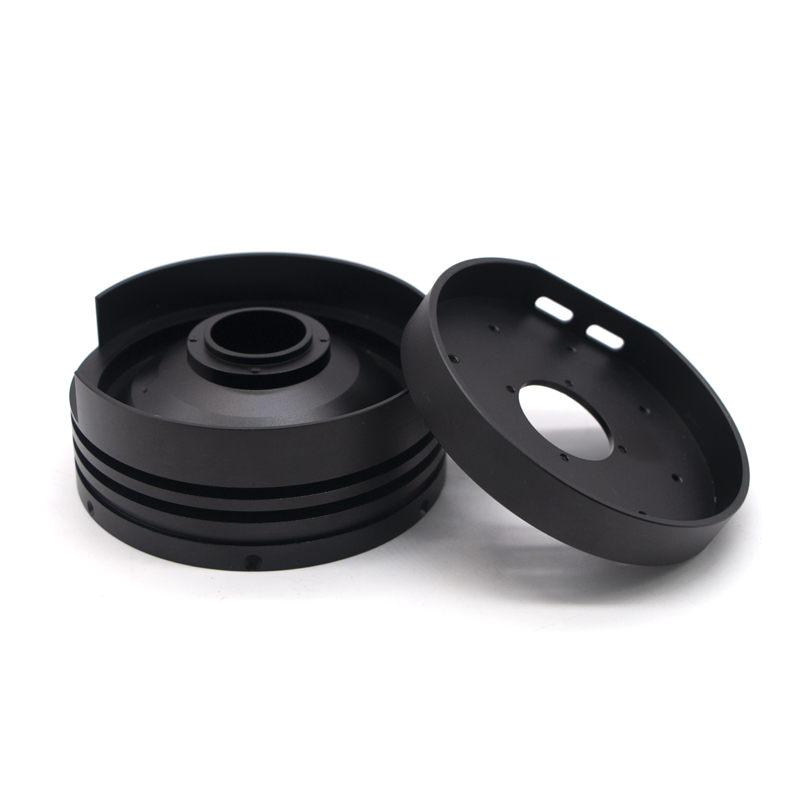
Extremely aesthetic appearance: The black anodized finish is sleek and visually appealing, making it a popular choice for consumer electronics, automotive parts, and architectural components. The uniform, matte, or glossy finish enhances the overall look of the product.
Corrosion resistance: The anodized layer provides excellent protection against corrosion, extending the life of the aluminum part, especially in harsh environments such as marine or industrial applications.
Cost-effectiveness: Compared to other surface treatments, black anodizing is relatively cost-effective. It provides long-lasting protection and an attractive finish without significantly increasing production costs.
Thermal stability: Anodized aluminum has better thermal stability compared to untreated aluminum. The anodized layer can withstand higher temperatures without degrading, making it suitable for applications exposed to heat.
High color retention: Black anodized aluminum retains its color well over time, especially when properly sealed. This makes it ideal for applications requiring long-term color stability, such as outdoor architectural elements or automotive trim.
No outgassing: Anodized surfaces do not outgas, making them suitable for applications in vacuum environments, such as in aerospace or certain industrial settings.
Environmental protection: The anodizing process is environmentally friendly, especially when compared to other coating methods like painting or plating. The process produces minimal hazardous waste and the finished product is non-toxic.
Improved adhesion: The porous nature of the anodized layer improves the adhesion of subsequent coatings, such as paints or adhesives, making it easier to apply additional treatments or finishes to the part.
Ductility: Anodizing does not significantly reduce the ductility of aluminum, meaning the material retains its ability to bend and flex without cracking.
Simple maintenance: Black anodized surfaces are easy to clean and maintain, requiring only mild cleaning agents and water to keep them looking new.
Lubrication: The porous anodized layer can retain lubricants, reducing friction in applications where sliding or rotating parts are involved, such as in machinery components.
Thermal emissivity: Anodized aluminum surfaces have higher thermal emissivity, which means they can radiate heat more efficiently. This property is beneficial in applications like heat sinks or other thermal management systems.
While black anodized aluminum offers many benefits, there are also some limitations and challenges associated with the process.
Difficult process: Black anodizing, particularly with organic dyes, requires careful control of the anodizing conditions and dyeing process to achieve consistent results. Variations in temperature, current, or dye concentration can lead to color inconsistencies or defects.
Fading: Although black anodizing is generally resistant to fading, prolonged exposure to UV light or harsh environmental conditions can cause some dyes to fade over time, particularly if organic dyes are used.
Material surface cracking: Anodizing can sometimes lead to micro-cracks in the oxide layer, especially if the anodizing conditions are not properly controlled. These cracks can reduce the effectiveness of the anodized layer in protecting the underlying metal.
Material limitations: Not all aluminum alloys are equally suitable for anodizing. Some alloys may not produce a uniform oxide layer, leading to variations in color and surface finish.
Coating Durability: While the anodized layer is hard and wear-resistant, it can be damaged by sharp impacts or abrasive materials. Once the anodized layer is breached, the underlying aluminum is exposed to corrosion.
Loss of Ductility: Although anodizing does not significantly affect aluminum's ductility, very thick anodized layers, such as those produced by hard anodizing, can reduce the material's flexibility, leading to cracking or failure under stress.
Masking Required: In applications where only specific areas of a part need to be anodized, masking is required to protect the non-anodized areas. This adds complexity and cost to the process.
Black oxide coating and black anodizing are both surface treatments used to enhance the appearance and performance of metal parts, but they differ significantly in their processes and outcomes. Black oxide is a chemical conversion coating used primarily on steel and iron. It provides a thin, decorative black finish that offers mild corrosion resistance. However, it is not as durable or hard as anodizing. Anodizing, on the other hand, involves electrochemical conversion, creating a thicker, more durable oxide layer. Anodized finishes are harder, more wear-resistant, and provide better corrosion protection compared to black oxide coatings. Additionally, anodizing can be applied to a broader range of metals, including aluminum, magnesium, and titanium, whereas black oxide is typically limited to ferrous metals.
Black anodizing is used across various industries due to its combination of aesthetic appeal, durability, and corrosion resistance. Below are some key applications where black anodized CNC machining parts are commonly employed.
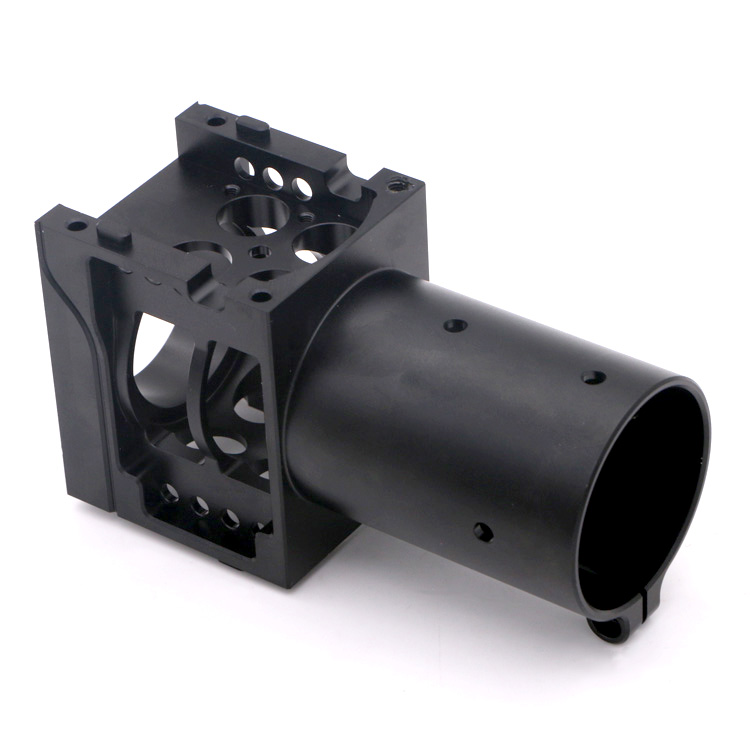
Architectural Components: Black anodized aluminum is frequently used in architectural applications, such as window frames, curtain walls, and decorative panels. Its sleek appearance and long-term durability make it ideal for both interior and exterior elements.
Automotive Components: In the automotive industry, black anodizing is used for parts like trim, handles, and engine components. The process provides a durable, corrosion-resistant finish that enhances the aesthetic appeal of vehicles.
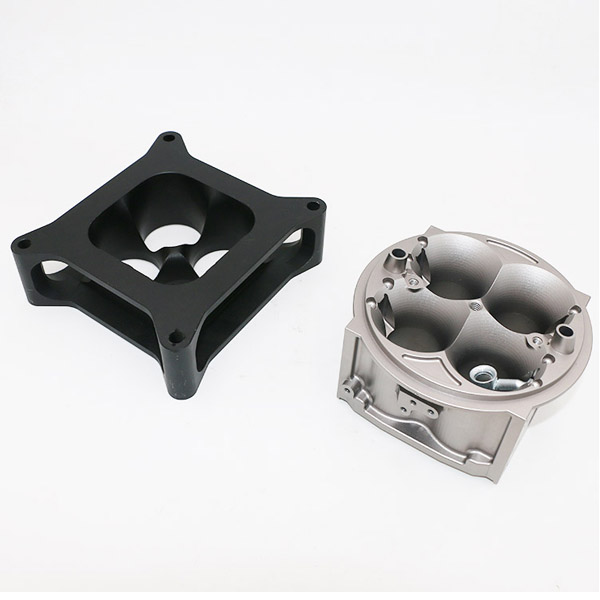
Medical Supplies: Anodized titanium and aluminum are used in medical devices and equipment due to their biocompatibility and resistance to corrosion. The black anodized finish is particularly valued for surgical tools, prosthetics, and implants.
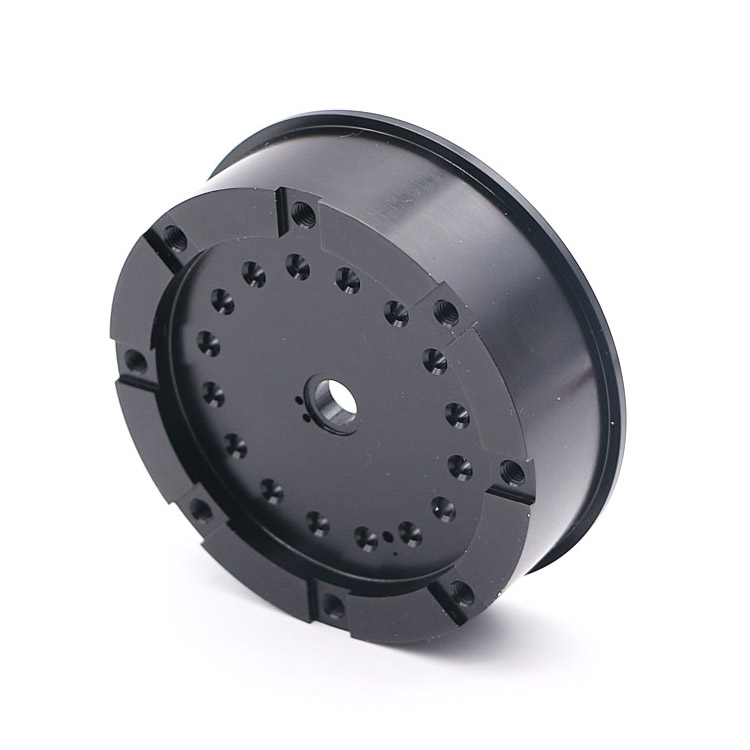
Electronic Housings: Black anodized aluminum is widely used in electronic housings, such as enclosures for computers, smartphones, and audio equipment. The finish provides excellent electromagnetic shielding, corrosion resistance, and a professional appearance.
Industrial Equipment and Machinery: Anodized components are used in industrial equipment and machinery for their durability and resistance to wear. The black anodized finish is particularly useful in applications where appearance and corrosion resistance are important.
Military and Defense Equipment: Black anodizing is used in military and defense equipment for parts that require both durability and low visibility. The process is applied to weapons, tactical gear, and other equipment exposed to harsh environments.
Sporting Goods: Black anodized aluminum is used in sporting goods such as bicycles, fishing gear, and firearms. The anodized finish provides a durable, attractive surface that resists scratches and corrosion.
Furniture: In furniture design, black anodized aluminum is used for frames and decorative elements. The finish provides a modern, sleek appearance and excellent durability, making it ideal for both indoor and outdoor furniture.
Restaurant Supplies: Black anodized cookware and utensils are popular in the restaurant industry due to their non-stick properties, durability, and ease of cleaning. The finish also provides a professional appearance that is resistant to corrosion and wear.
As a leading provider of CNC machining services, VMT offers comprehensive surface treatment solutions, including black anodizing, to meet the diverse needs of our clients. Our state-of-the-art facilities and experienced technicians ensure that each part is anodized to the highest standards, providing superior quality and consistency. Whether you need black anodized CNC machining parts for automotive, aerospace, or any other industry, VMT is equipped to deliver precision and excellence in every project. Our services include custom CNC machining, CNC prototype machining, and a variety of other surface treatments to meet your specific requirements.
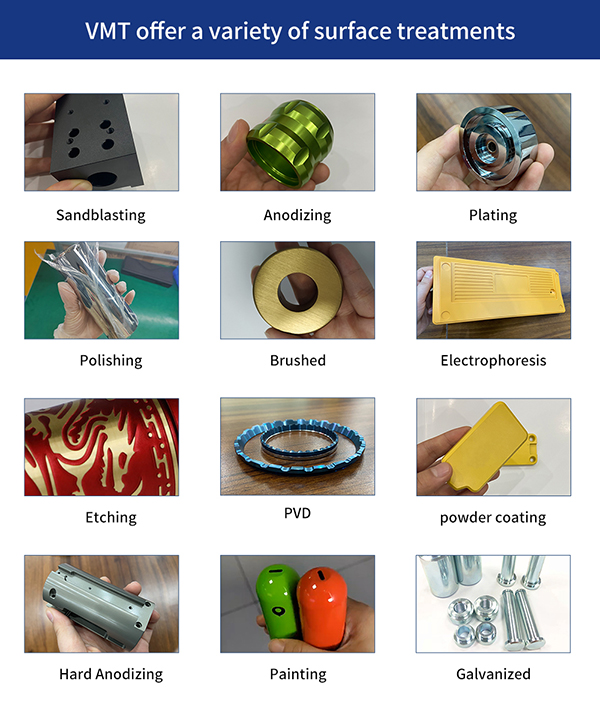
Black anodizing is a highly effective surface treatment that enhances both the appearance and performance of metal parts, particularly aluminum. Its combination of aesthetic appeal, durability, and corrosion resistance makes it a preferred choice across numerous industries, from automotive to aerospace to electronics. Understanding the process, materials, advantages, and limitations of black anodizing allows manufacturers and designers to make informed decisions when selecting surface treatments for their products. With the right expertise and equipment, black anodized CNC machining parts can achieve superior quality and longevity, ensuring that they meet the demands of modern applications.

Will Black Anodized Surfaces Fade, Rust, or Scratch?
Black anodized surfaces are highly resistant to fading, rusting, and scratching due to the protective oxide layer. However, over time, exposure to harsh conditions can cause some fading or wear, particularly if the anodized layer is not properly sealed or maintained.
What Are the Benefits of Black Anodized Aluminum?
The benefits of black anodized aluminum include enhanced corrosion resistance, improved durability, aesthetic appeal, thermal stability, and cost-effectiveness. It also offers environmental protection and improved adhesion for additional coatings.
What Is Black Anodizing?
Black anodizing is an electrochemical process that creates a durable oxide layer on metal surfaces, which is then dyed black. This process enhances the metal’s appearance and provides improved resistance to wear and corrosion.
Will Black Anodized Aluminum Fade?
While black anodized aluminum is resistant to fading, prolonged exposure to UV light or harsh environmental conditions can cause some fading over time, particularly if organic dyes are used.
How Long Does Anodizing Last?
Anodizing can last for decades if properly maintained. The lifespan depends on factors such as the thickness of the anodized layer, the environment in which the part is used, and the type of dye and sealing process applied.
Is Anodizing Better Than Aluminum?
Anodizing significantly improves the surface properties of aluminum, making it harder, more resistant to corrosion, and more aesthetically pleasing. It is generally considered better than untreated aluminum for most applications.
How to Prevent Anodizing from Fading?
To prevent anodizing from fading, ensure that the anodized layer is properly sealed and protected from prolonged exposure to UV light and harsh environmental conditions. Regular cleaning and maintenance can also help preserve the finish.
Can Anodizing Coatings Be Removed?
Yes, anodizing coatings can be removed through chemical stripping or mechanical abrasion. However, this process requires care to avoid damaging the underlying metal.
How Long Does It Take for Aluminum to Be Black Anodized?
The time required for black anodizing aluminum depends on the size and complexity of the part, the desired thickness of the oxide layer, and the dyeing process. Typically, the entire process can take from a few hours to a full day.
Can Steel Be Black Anodized?
Steel cannot be anodized in the same way as aluminum because it does not form a stable oxide layer. However, steel can be treated with other processes, such as black oxide coating, to achieve a similar appearance.
How Much Does It Cost to Black Anodize Metal?
The cost of black anodizing depends on factors such as the size and complexity of the part, the thickness of the anodized layer, and the type of dye used. It is generally more cost-effective than other surface treatments like plating or painting.
How to Clean Black Anodized Metal?
Black anodized metal can be cleaned using mild soap and water. Avoid using abrasive cleaners or harsh chemicals, as these can damage the anodized surface. Regular cleaning helps maintain the appearance and durability of the finish.
Is Black Anodizing Environmentally Friendly?
Black anodizing is considered environmentally friendly because it produces minimal hazardous waste and uses non-toxic materials. The anodized finish is also non-toxic and safe for various applications, including food contact and medical devices.
This comprehensive guide provides an in-depth understanding of black anodizing, from the process and materials involved to its applications and benefits. By following this framework, you can ensure that your CNC machined parts meet the highest standards of quality and durability while achieving the desired aesthetic appeal.
